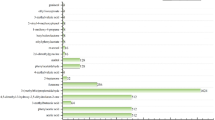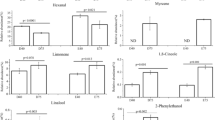Abstract
To characterize the aroma of cooked Korean non-aromatic rice, volatiles were extracted by simultaneous steam distillation and solvent extraction (SDE) and dynamic headspace sampling (DHS). The potent aroma-active compounds were then evaluated using gas chromatography-olfactometry. A total of 16 aroma-active compounds with log3 flavor dilution >1 were detected by SDE. On the other hand, 10 aroma-active compounds were detected by DHS. 2-Methyl-3-furanthiol (2-MF) and 2-acetyl-1-pyrroline were considered the most potent aroma-active compounds in cooked Korean non-aromatic rice. Especially, 2-MF was identified for the first time as a potential aroma-active compound of cooked Korean non-aromatic rice.
Similar content being viewed by others
References
Singh RK, Singh US, Khush GS. Prologue. pp 1–3. In: Aromatic Rices. Singh RK, Singh US, Khush GS (eds). Science Publishers Inc, Enfield, NH, USA (2000)
Maarse H. Rice. pp. 79–89. In: Volatile Compounds in Foods and Beverages. Maarse H (ed). Marcel Dekker Inc, New York, NY, USA (1991)
Yajima I, Yanai T, Nakamura M. Sakakibara H, Hayashi K. Volatile flavor components of cooked ‘Kaorimai’ (scented rice, O. sativa japonica). Agr. Biol. Chem. Tokyo 43: 2425–229 (1979)
Widjaja R, Craske JD, Wootton M. Comparative studies on volatile components of non-fragrant and fragrant rices. J. Sci. Food Agr. 70: 151–161 (1996)
Jezussek M, Juliano BO, Schieberle P. Comparison of key aroma compounds in cooked brown rice varieties based on aroma extract dilution analyses. J. Agr. Food Chem. 50: 1101–1105 (2002)
Champagne ET. Rice aroma and flavor: A literature review. Cereal Chem. 85: 445–454 (2008)
Maga JA. Rice product volatiles: A review. J. Agr. Food Chem. 32: 964–970 (1984)
Tsugita T. Aroma of cooked rice. Food Rev. Int. 1: 497–520 (1985)
Weber DJ, Rohilla R, Singh US. Chemistry and biochemistry of aroma in scented rice. pp. 29–46. In: Aromatic Rices. Singh RK, Singh US, Khush GS (eds). Science Publishers Inc., Enfield, NH, USA (2000)
Zeng Z, Zhang H, Chen JY, Zhang T, Matsunaga R. Flavor volatiles of rice during cooking analyzed by modified headspace SPME/GCMS. Cereal Chem. 85: 140–145 (2008)
Mahatheeranont S, Keawsa-ard S, Dumri K. Quantification of the rice aroma compound, 2-acetyl-1-pyrroline, in uncooked Khao Dawk Mali 105 brown rice. J. Agr. Food Chem. 49: 773–779 (2001)
Kim CY, Lee JC, Kim YH, Pyon JY, Lee SG. Volatile flavor components of scent, colored, and common rice cultivars in Korea. Korean J. Crop Sci. 44: 181–185 (1999)
Lee JC, Kim YH. Comparison of volatile flavor components of Korean aromatic rice and nonaromatic rice. J. Korean Soc. Food Sci. Nutr. 28: 299–304 (1999)
Yang DS, Lee KS, Jeong OY, Kim KJ, Kays SJ. Characterization of volatile aroma compounds in cooked black rice. J. Agr. Food Chem. 56: 235–240 (2008)
Yang DS, Shewfelt RL, Lee KS, Kays SJ. Comparison of odoractive compounds from six distinctly different rice flavor types. J. Agr. Food Chem. 56: 2780–2787 (2008)
Buttery RG, Ling LC, Juliano BO, Turnbaugh JG. Cooked rice aroma and 2-acetyl-1-pyrroline. J. Agr. Food Chem. 31: 823–826 (1983)
Hofmann T, Schieberle P. Evaluation of the key odorants in a thermally treated solution of ribose and cysteine by aroma extract dilution techniques. J. Agr. Food Chem. 43: 2187–2194 (1995)
Blank I, Sen A, Grosch W. Potent odorants of the roasted power and brew of Arabica coffee. Z. Lebensm. Unters. For. 195: 239–245 (1992)
Kerscher R, Grosch W. Comparative evaluation of potent odorants of boiled beef by aroma extract dilution analysis and concentration analysis. Z. Lebensm. Unters. For. 204: 3–6 (1997)
Tominaga T, Dubourdieu D. A novel method for quantification of 2-methyl-3-furanthiol and 2-furanmethanethiol in wines made from Vitis vinifera grape varieties. J. Agr. Food Chem. 54: 29–33 (2006)
Ames JM, MacLeod G. Volatile components of a yeast extract composition. J. Food Sci. 50: 125–131, 135 (1985)
Withycombe DA, Mussinan CJ. Identification of 2-methyl-3-furanthiol in the steam distillate from canned tuna fish. J. Food Sci. 53: 658–660 (1988)
Gasser U, Grosch W. Identification of volatile flavor compounds with high aroma values from cooked beef. Z. Lebensm. Unters. For. 186: 489–494 (1988)
Molyneux RJ, Schieberle P. Compound identification: A journal of agricultural and food chemistry perspective. J. Agr. Food Chem. 55: 4625–4629 (2007)
Blank I. Gas chromatography-olfactometry in food aroma analysis. pp. 297–331. In: Flavor, Fragrance, and Odor Analysis. Marsili R (ed). Marcel Dekker Inc., New York, NY, USA (2002)
Park JK, Kim SS, Kim KO. Effect of milling ratio on sensory properties of cooked rice and on physicochemical properties of milled and cooked rice. Cereal Chem. 78: 151–156 (2001)
Meullenet JC, Marks BP, Griffin K, Daniels MJ. Effects of rough rice drying and storage conditions on sensory profiles of cooked rice. Cereal Chem. 76: 483–486 (1999)
Champagne ET, Bett KL, Vinyard BT, Webb BD, McClung AM, Barton FE, Lyon BG, Moldenhauer K, Linscombe S, Kohlwey D. Effect of drying conditions, final moisture content, and degree of milling on rice flavor. Cereal Chem. 74: 566–570 (1997)
Yoshihashi T, Huong NTT, Inatomi H. Precursors of 2-acetyl-1-pyrroline, a potent flavor compound of an aromatic rice variety. J. Agr. Food Chem. 50: 2001–2004 (2002)
Sakthivel K, Sundaram RM, Shobha Rani N, Balachandran SM, Neeraja CN. Genetic and molecular basis of fragrance in rice. Biotechnol. Adv. 27: 468–473 (2009)
Author information
Authors and Affiliations
Corresponding author
Rights and permissions
About this article
Cite this article
Park, J.S., Kim, KY. & Baek, H.H. Potent aroma-active compounds of cooked Korean non-aromatic rice. Food Sci Biotechnol 19, 1403–1407 (2010). https://doi.org/10.1007/s10068-010-0200-1
Received:
Revised:
Accepted:
Published:
Issue Date:
DOI: https://doi.org/10.1007/s10068-010-0200-1




